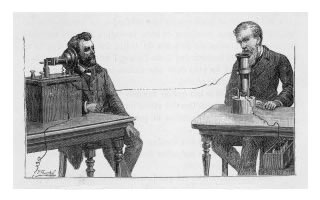 |
 All Classic Ads Vintage Collection - Bell related ads All Classic Ads Vintage Collection - Bell related ads
Ad • Ad

|
|
History of the Bell Company (1906)
 In the 1870s, two inventors Elisha Gray and Alexander Graham Bell both independently designed devices that could transmit speech electrically (the telephone). Both men rushed their respective designs to the patent office within hours of each other, Alexander Graham Bell patented his telephone first. Elisha Gray and Alexander Graham Bell entered into a famous legal battle over the invention of the telephone, which Bell won. In the 1870s, two inventors Elisha Gray and Alexander Graham Bell both independently designed devices that could transmit speech electrically (the telephone). Both men rushed their respective designs to the patent office within hours of each other, Alexander Graham Bell patented his telephone first. Elisha Gray and Alexander Graham Bell entered into a famous legal battle over the invention of the telephone, which Bell won.
Alexander Graham Bell - Evolution of the Telegraph into the Telephone
The telegraph and telephone are both wire-based electrical systems, and Alexander Graham Bell's success with the telephone came as a direct result of his attempts to improve the telegraph.
When Bell began experimenting with electrical signals, the telegraph had been an established means of communication for some 30 years. Although a highly successful system, the telegraph, with its dot-and-dash Morse code, was basically limited to receiving and sending one message at a time. Bell's extensive knowledge of the nature of sound and his understanding of music enabled him to conjecture the possibility of transmitting multiple messages over the same wire at the same time. Although the idea of a multiple telegraph had been in existence for some time, Bell offered his own musical or harmonic approach as a possible practical solution. His "harmonic telegraph" was based on the principle that several notes could be sent simultaneously along the same wire if the notes or signals differed in pitch.
Alexander Graham Bell - Talk with Electricity
By October 1874, Bell's research had progressed to the extent that he could inform his future father-in-law, Boston attorney Gardiner Greene Hubbard, about the possibility of a multiple telegraph. Hubbard, who resented the absolute control then exerted by the Western Union Telegraph Company, instantly saw the potential for breaking such a monopoly and gave Bell the financial backing he needed. Bell proceeded with his work on the multiple telegraph, but he did not tell Hubbard that he and Thomas Watson, a young electrician whose services he had enlisted, were also exploring an idea that had occurred to him that summer - that of developing a device that would transmit speech electrically.
While Alexander Graham Bell and Thomas Watson worked on the harmonic telegraph at the insistent urging of Hubbard and other backers, Bell nonetheless met in March 1875 with Joseph Henry, the respected director of the Smithsonian Institution, who listened to Bell's ideas for a telephone and offered encouraging words. Spurred on by Henry's positive opinion, Bell and Watson continued their work. By June 1875 the goal of creating a device that would transmit speech electrically was about to be realized. They had proven that different tones would vary the strength of an electric current in a wire. To achieve success they therefore needed only to build a working transmitter with a membrane capable of varying electronic currents and a receiver that would reproduce these variations in audible frequencies.
First Sounds - Twang
On June 2, 1875, Alexander Graham Bell while experimenting with his technique called "harmonic telegraph" discovered he could hear sound over a wire. The sound was that of a twanging clock spring.
Bell's greatest success was achieved on March 10, 1876, marked not only the birth of the telephone but the death of the multiple telegraph as well. The communications potential contained in his demonstration of being able to "talk with electricity" far outweighed anything that simply increasing the capability of a dot-and-dash system could imply.
First Voice - Mr. Watson, come here. I want to see you.
Alexander Graham Bell's notebook entry of 10 March 1876 describes his successful experiment with the telephone. Speaking through the instrument to his assistant, Thomas A. Watson, in the next room, Bell utters these famous first words, "Mr. Watson -- come here -- I want to see you."
AVAILABLE Bell ADS BY DATE AND CATEGORY
1900 - 1919 |
1940 - 1949 |
1970 - 1979 |
|
|
|
1920 - 1929 |
1950 - 1959 |
1980 - 1989 |
|
|
|
1930 - 1939 |
1960 - 1969 |
1990 - 1999 |
|
|
|
 |
Size -
Grading -
Availability -
Price -
Publishing Date:
Magazine:
Shipping and handling fees - verify postal code
Catalog ID:

|
 |
Size -
Grading -
Availability -
Price -
Publishing Date:
Magazine:
Shipping and handling fees - verify postal code
Catalog ID:

|
|
|



